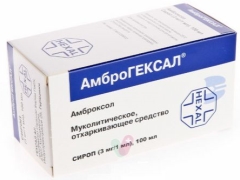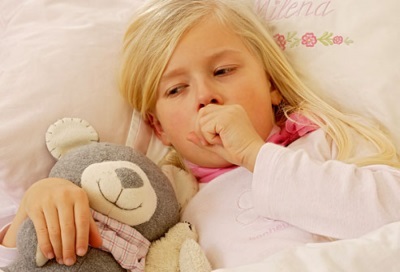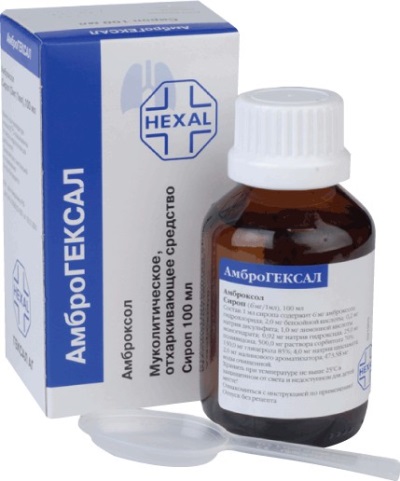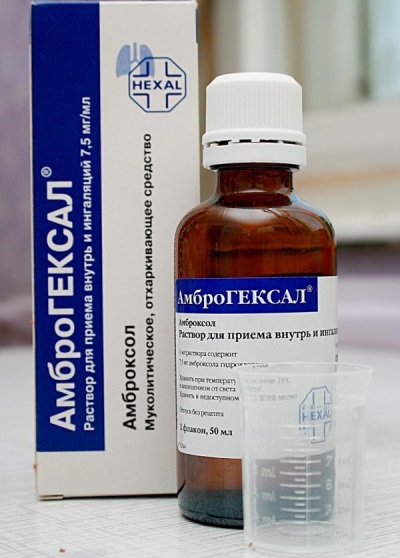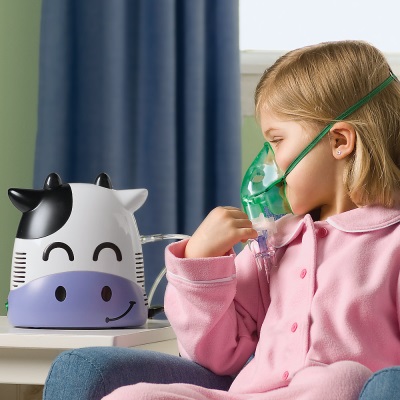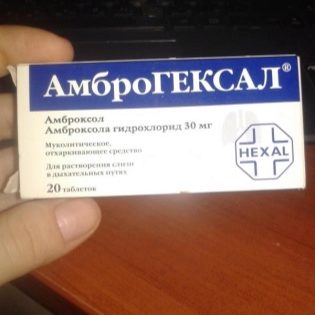Ambrohexal: instructions for use for children
Every mother faces a cough in a child, and since this symptom causes severe discomfort in children, I want to help a coughing child as soon as possible. If the sputum in the bronchi is too thick and it is hard for the baby to cough up, the pediatrician will recommend mucolytic drugs. One of them is AmbroGEXAL. Is it possible to give this drug to children up to a year, how does the children's organism react to its active substance, how is AmbroGEXAL dispensed correctly and what drugs can it be replaced with?
Release form
AmbroGSAL is available in the following options:
- Syrup. It is represented by a colorless or yellowish liquid, packaged in dark glass bottles of 100 ml or 250 ml. The concentration of the active substance in such Ambrohexal is 3 mg or 6 mg in 1 ml. Packaging includes measuring spoon.
- Solutionwhich is used internally or inhaled with it. Such liquid transparent AmbroGEXAL without color is poured into glass vials in the form of a dropper with a capacity of 50 or 100 ml. Each milliliter of the drug (20 drops) contains 7.5 mg of active compound. The package has a measuring cup.
- Pills. They have a white color and a round shape. The content of the active substance in each tablet is 30 mg. Packaging can hold from 10 to 100 tablets, and one blister contains 10 or 20 pieces.
- Capsules. These are white dense capsules which contain 75 mg of active substance in each and are distinguished by their long-lasting action. One pack includes 10, 20, 50 or 100 capsules packed in blisters of 10 pieces.
Composition
- The main component in Ambrohexal is represented by ambroxol hydrochloride.
- In addition to the syrup, water, sorbitol solution, apricot or raspberry flavor, glycerol, propylene glycol and other substances are added.
- In addition to ambroxol tablets, calcium phosphate, silicon dioxide, corn starch, milk sugar, sodium carboxymethyl starch, and magnesium stearate are present in the tablets.
- Ambrohexal solution contains water, Na hydroxide, propyl and methyl parahydroxybenzoate, Na metabisulphite and citric acid.
- Additional components of Ambrohexal capsules are gelatin, titanium dioxide, cellulose, dyes and other components.
Operating principle
The drug is classified as mucolytic expectorant drugs, because it changes the structure of polysaccharides that are in sputum. In addition, Ambroxol enhances the production of glycoproteins. The result of this action will be a decrease in the viscosity of secretion formed in the bronchi and trachea.
Ambrohexal intake also affects the ciliated epithelium of the bronchial tree, stimulating the movement of its cilia. The drug has a positive effect on the formation of surfactant - Ambroxol improves its synthesis and prevents its disintegration.
Videoinstrukuyu to the drug can be found here:
Indications
Ambrohexal can be taken with:
- Respiratory Distress Syndrome.
- Ostrom bronchitis.
- Inflammation of the lungs.
- Chronic bronchitis.
- Bronchiectasis.
- Asthma
- COPD
Surely you will be interested in the video program of Dr. Evgeny Komarovsky, dedicated to the problem of children's cough:
Drugs with Ambroxol are recommended for excessively viscous sputum, if it moves away with great difficulty.
At what age is it allowed to take?
Ambrohexal can be given to children from birth, but a child under two years old (for example, at the age of 2 months) while taking this medicine should be under the supervision of a pediatrician.
Babies give the drug in the form of a syrup with a dosage of 3 mg / ml or solution, which is taken orally. Ambrohexal tablet form is prescribed to children 6 years and older. The use of ambrogexal capsules is permitted from the age of 12 years.
Contraindications
Instructions for use for children prohibits to give Ambrohexal in such situations:
- If the child has hypersensitivity to ambroxol or other components of the medication.
- If the patient has an ulcerative lesion of the digestive tract.
- With convulsive syndrome.
- If the motility of the bronchi is impaired or the secret is secreted in the bronchial tree in an excessively large volume. In such cases, the risk of mucus stagnation increases.
The use of Ambrohexal is limited in pathologies of the liver or kidneys. The tablet form is contraindicated in case of lactase deficiency or lactose allergy, and syrup should not be given to children with fructose intolerance.
Side effects
Rare side effects of taking Ambrohexal are:
- Diarrhea.
- Headache.
- Hives.
- Constipation.
- Weakness.
- Dryness of the mucous membranes of the mouth and nasopharynx.
- Rash on the skin.
- Nasal discharge.
- Urination problems.
- Angioedema.
Instructions for use and dose
The dosage and frequency of use of Ambrohexal will depend on the age of the patient and the severity of clinical manifestations. To make Ambrohexal's mucolytic effect more pronounced, the child should be given plenty of fluids, such as water, tea, or juice. The severity of the disease will affect the duration of therapy, but you should not take the drug for more than 4-5 days without consulting a doctor.
Syrup
In a measuring spoon of syrup with ambroxol concentration of 3 mg / ml contains 15 mg of the active substance. This form of medicine is given by mouth in such a single dosage:
Child under five years old | 2.5 ml (half measuring spoons) |
Child aged 6 to 12 years | 5 ml (full measuring spoon) |
Child 12 years and older | 10 ml (2 full spoons) |
In a measuring spoon of syrup with ambroxol concentration of 6 mg / ml contains 30 mg of the active ingredient. Single dose of this Ambrohexal:
Child under 5 years old | 1.25 ml (quarter measuring spoon) |
Child 6-12 years old | 2.5 ml (half a measuring spoon) |
Child over 12 years old | 5 ml (full measuring spoon) |
The maximum daily dosage for children aged 12 years and older will be 120 mg of ambroxol, which corresponds to four measuring spoons of 6mg / ml syrup.
The frequency of use in children under two years of age - twice a day. A child of 2-5 years old gives the drug 3 times a day, and at 6-12 years of age - from two to 3 times a day. For children 12 years and older in the first two or three days of treatment, the medicine is given three times a day, and then transferred to a double dose.
Solution
This form of Ambrohexal is dosed in drops. For internal use are guided by such doses:
Children under 2 years | 20 drops twice a day |
Children from 2 to 5 years | 20 drops thrice a day |
Children from 6 to 12 years | 2 or 3 times a day, 40 drops |
Children over 12 years old | 80 drops three times a day, and after 2-3 days from the start of treatment, they start giving 80 drops twice a day. |
The right amount of drops must be diluted with tea, water, juice or milk.
If the child is inhaled with ambrohexal and saline, the procedure is performed once a day, but it can be done twice.For babies under five years of age, 40 drops of the drug (2 ml) are taken per inhalation, and a child over 5 years old will take the dosage of Ambrohexal for one inhalation from 40 to 60 drops (2-3 ml).
The procedure is done with the help of modern inhalers, adding to the desired volume of Ambrohexal the same amount of saline. For example, the proportion for a child of 4 years will be 2 ml of Ambrohexal + 2 ml of saline. The mixture is heated to body temperature.
Pills
Such Ambrohexal is given after meals. The tablet should be swallowed and then washed down with a sufficient amount of water. At the age of 6-12 years a single dosage of this form of the drug will be half a tablet. It is given to a child 2 or 3 times a day.
If the child is already 12 years old, the dosage is increased to a whole pill. At this age, AmbroGEXAL begins to be given three times a day, and after 2-3 days from the beginning of the administration, they switch to double use.
Capsules
A child older than 12 years old is given this form of Ambrohexal in the morning and in the evening one capsule. The medicine is offered after meals. Chew the capsule should not be swallowed, it is washed down with a liquid in a large volume.
Overdose
Too high a dose of ambrohexal causes vomiting, abdominal pain, severe salivation, severe nausea, and decreased blood pressure. In such a situation, it is recommended to flush the stomach and give fat-containing products. If the condition is severe, you need to consult a doctor for the appointment of another treatment.
Interaction with other drugs
- AmbroGEXAL and antitussive medications should not be prescribed to the child, since such a combination of medications, while helping to eliminate cough, will worsen sputum production.
- If you use Ambrohexal with antibiotics such as Doxycycline, Erythromycin, cefuroxime or Amoxicillintheir penetration into the secret of the bronchi will be enhanced.
Terms of sale
You can buy AmbroGeSAL at a pharmacy without a prescription from a doctor. The price of 20 tablets is about 100 rubles. Approximately the same cost is noted for 3mg / ml syrup in a solution.
Shelf life and storage conditions
To Ambrogekal not lost therapeutic properties, it should be kept in a dry, distant from the children, dark place, where the temperature will not rise above + 25 ° C. The shelf life of the syrup is 2 years, the capsules are 3 years, and the solution is 4 years. Tablets can be stored up to 5 years.
Reviews
The use of Ambrohexal in the treatment of cough in a child speak mostly positively. Most parents confirm that the drug effectively dilutes sputum, relieves cough and contributes to a more rapid recovery from bronchitis, pneumonia, or other pathologies of the respiratory tract.
According to the reviews of moms, kids carry AmbroGEXAL mostly normally. Occasionally, an allergic reaction is noted, such as a skin rash or angioedema. In some children, the drug caused a negative reaction in the digestive tract. Also There are reviews in which mothers complain about the increased excitability of the child’s nervous system as a result of taking Ambrohexal.
Analogs
Any other medicinal product, the main ingredient of which is Ambroxol, can be a replacement for AmbroGEXAL. There are such analogues:
- Ambrobene.
- Lasolvan.
- Ambroxol.
- Ambrosan.
- Flamed.
- Bronchus.
- Bronchoxol.
- Medox.
- Ambrolan.
- Drops Bronchovern.
- Halixol.
Instead of AmbroGEXAL, the doctor may also prescribe other cough medicine, for example:
- Althea syrup.
- ACC.
- Bromhexine.
- Herbion syrups.
- Carbocisteine.
- Dry Cough Syrup.
- Prospan.
- Licorice Syrup.
- Fluimucil.
- Tussamag.
- Gedelix.
